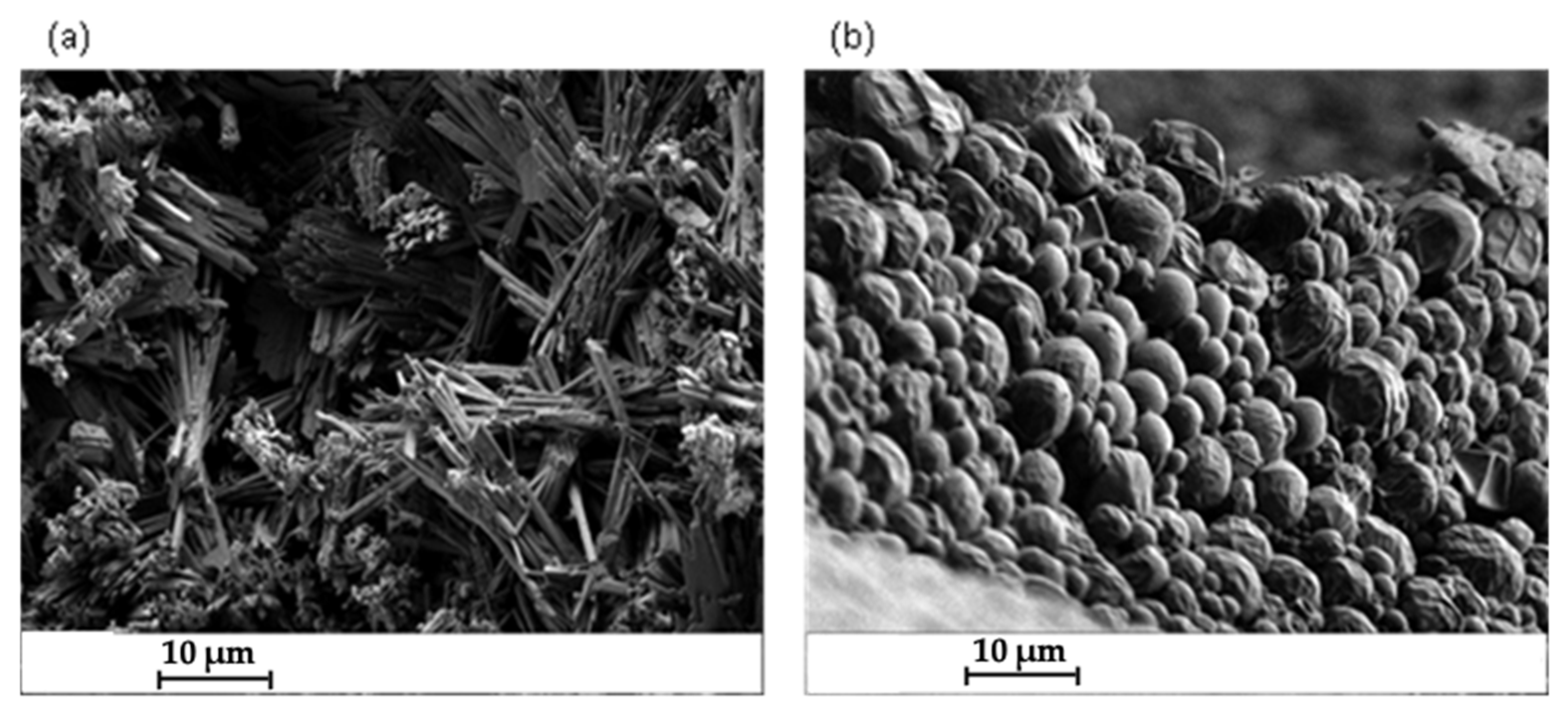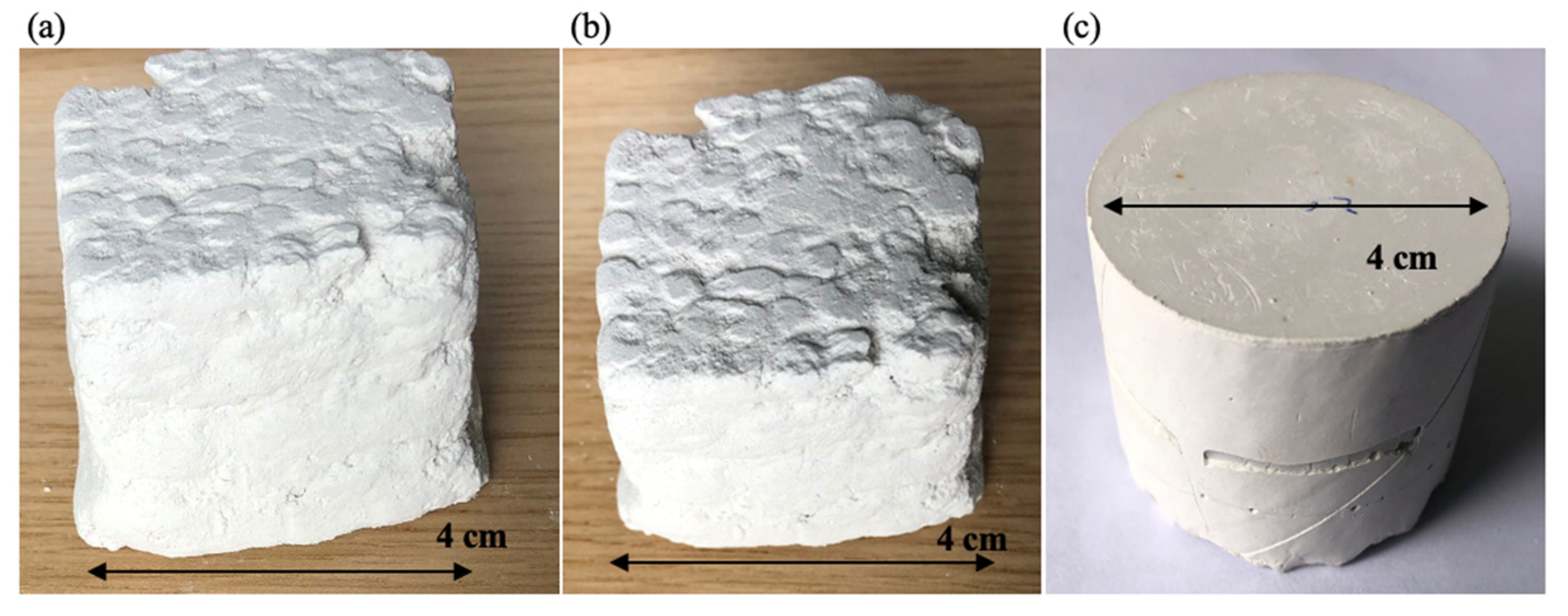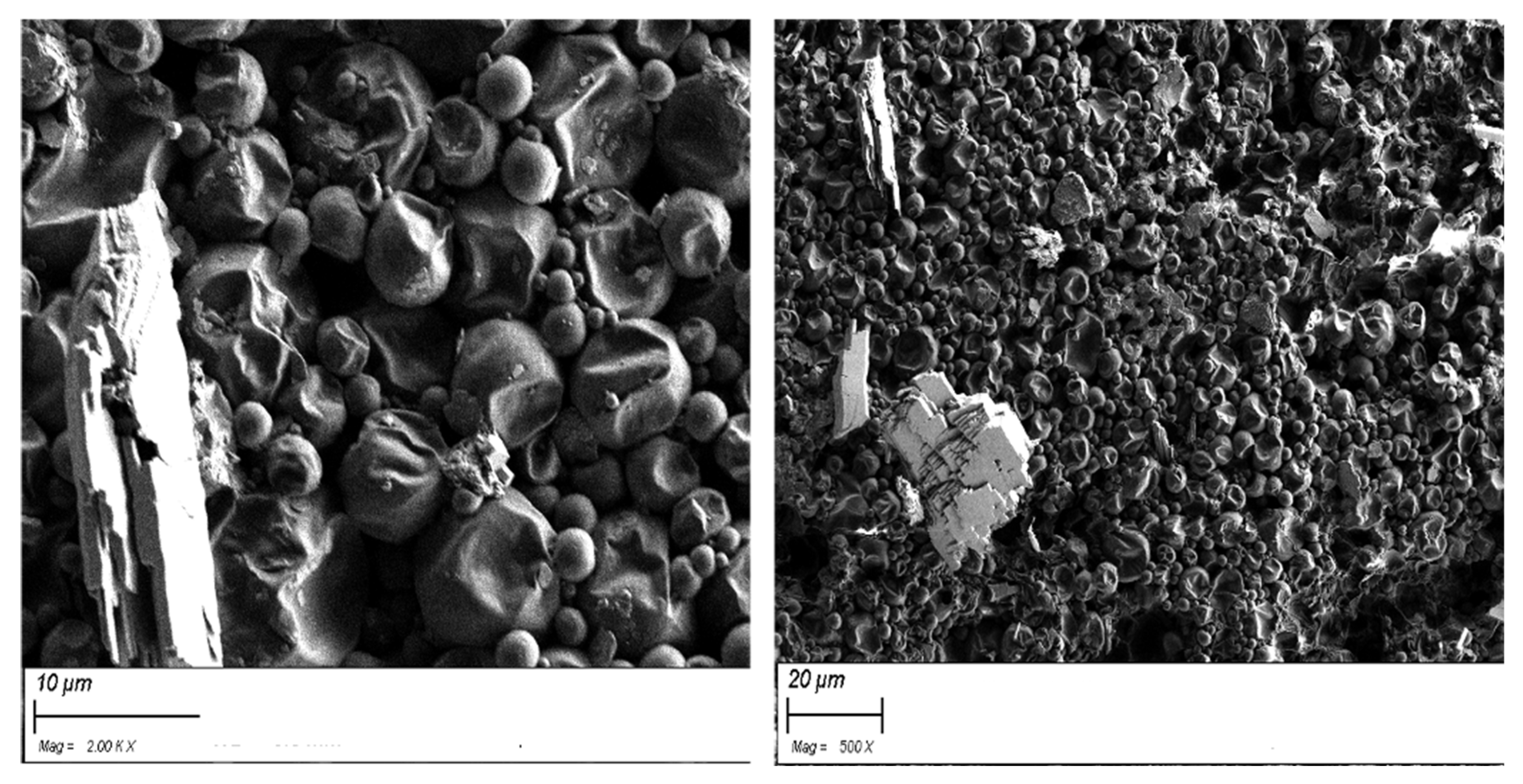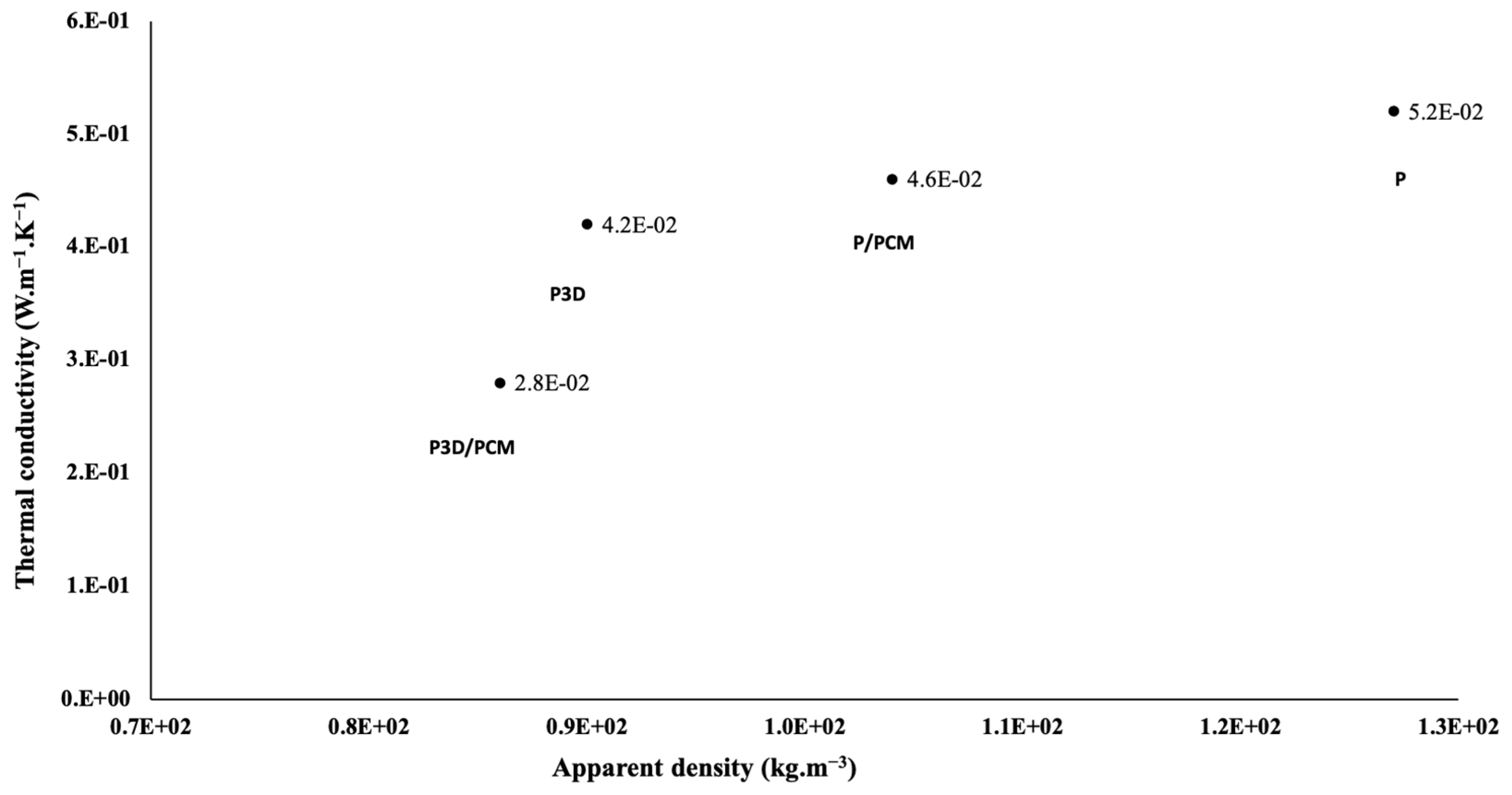Three-Dimensionally Printed Gypsum Located Within Micro-Encapsulated Phase Change Material: Thermal Conductivity Benefits of Selective Activation Technique
Abstract
1. Introduction
2. Materials and Methods
2.1. Calcium Sulfate and Phase Change Materials
2.2. 3D Printer
2.3. Suspension Preparation
2.4. Thermal Conductivity Measurements
3. Results
3.1. Influence of the Mixing Procedure
3.2. Observations of the Printed P/PCM Samples
3.3. Comparison Between Homogenized and 3D-Printed Samples
4. Conclusions
Author Contributions
Funding
Institutional Review Board Statement
Informed Consent Statement
Data Availability Statement
Acknowledgments
Conflicts of Interest
References
- United Nations Environment Programme. Building Materials and the Climate: Construction a New Future; United Nations Environment Programme: Nairobi, Kenya, 2023. [Google Scholar]
- United Nations Environment Programme. Global Status Report for Buildings and Construction: Beyond Foundations: Mainstreaming Sustainable Solutions to Cut Emissions from the Buildings Sector; United Nations Environment Programme: Nairobi, Kenya, 2024. [Google Scholar]
- Rathore, P.K.S.; Gupta, N.K.; Yadav, D.; Shukla, S.K.; Kaul, S. Thermal performance of the building envelope integrated with phase change material for thermal energy storage: An updated review. Sustain. Cities Soc. 2022, 79, 103690. [Google Scholar] [CrossRef]
- Santamouris, M.; Feng, J. Recent progress in daytime radiative cooling: Is it the air conditioner of the future? Buildings 2018, 8, 168. [Google Scholar] [CrossRef]
- Phase Change Material Market by Type (Organic, Inorganic), Application (Building & Construction, HVAC, Cold Chain & Pack-aging, Thermal Energy Storage, Textile, Electronics), Region—Global Fore-cast to 2025. Mark. Mark. 2020. Available online: https://www.researchandmarkets.com/report/phase-change-material?utm_source=GNOM&utm_medium=PressRelease&utm_code=pvhpmf&utm_campaign=1457343+-+Global+Phase+Change+Material+Market+(2020+to+2025)+-+Rising+Need+for+Cold+Chain+Logistics+Presents+Opportunities&utm_exec=jamu273prd (accessed on 5 February 2025).
- Pomianowski, M.; Heiselberg, P.; Zhang, Y. Review of thermal energy storage technologies based on PCM application in buildings. Energy Build. 2013, 67, 56–69. [Google Scholar] [CrossRef]
- El Yassi, M.; El Abbassi, I.; Pierre, A.; Melinge, Y. Comparative study of two combining a standard building materials with a PCM. Fluid Dyn. Mater. Proc. 2022, 19, 1283–1290. [Google Scholar] [CrossRef]
- Borreguero, A.; Serrano, A.; Garrido, J.-F.; Rodriguez, M. Polymeric-SiO2-PCMs for improving the thermal properties of gypsum applied in energy efficient buildings. Energy Convers. Manag. 2014, 87, 138–144. [Google Scholar] [CrossRef]
- Sinka, M.; Bajare, D.; Jakovics, A.; Ratnieks, J.; Gendelis, S.; Tihana, J. Experimental Testing of Phase Change Materials in a Warm-Summer Humid Continental Climate. Energy Build. 2019, 195, 205–215. [Google Scholar] [CrossRef]
- Marani, A.; Nehdi, M. Integrating phase change materials in construction materials: Critical review. Constr. Build. Mater. 2019, 217, 205–215. [Google Scholar] [CrossRef]
- Saffari, M.; Gracia, A.; Ushak, S.; Cabeza, L. Passive cooling of buildings with phase change materials using whole-building energy simulation tools: A review. Renew. Sustain. Energy Rev. 2017, 80, 1239–1255. [Google Scholar] [CrossRef]
- Rathore, P.-K.; Shukla, S.-K. Potential of macroencapsulated PCM for thermal energy storage in buildings: A comprehensive review. Constr. Build. Mater. 2019, 225, 723–744. [Google Scholar] [CrossRef]
- Ling, T.-C.; Poon, C.-S. Use of phase change materials for thermal energy storage in concrete: An overview. Constr. Build. Mater. 2013, 74, 55–62. [Google Scholar] [CrossRef]
- Hawlader, M.; Uddin, M.; Khin, M.-M. Microencapsulated PCM thermal-energy storage system. Appl. Energy 2003, 74, 195–202. [Google Scholar] [CrossRef]
- Zhang, Y.; Zhou, G.; Lin, K.; Zhang, H. Application of latent heat thermal energy storage in buildings: State-of-the-art and outlook. Build. Environ. 2007, 42, 2197–2209. [Google Scholar] [CrossRef]
- Rathore, P.-K.; Shukla, S. Enhanced thermophysical properties of organic PCM through shape stabilization for thermal energy storage in buildings: A state of the art review. Energy Build. 2021, 236, 110799. [Google Scholar] [CrossRef]
- Kuznik, F.; David, D.; Johannes, K.; Roux, J.-J. A review on phase change materials integrated in building walls. Renew. Sustain. Energy Rev. 2011, 15, 379–391. [Google Scholar] [CrossRef]
- Regin, A.F.; Solanki, S.; Saini, J.S. An analysis of a packed bed latent heat thermal energy storage system using PCM capsules: Numerical investigation. Renew. Energy 2009, 34, 1765–1773. [Google Scholar] [CrossRef]
- Schutter, G.; Mechterine, V.; Habert, G. Technical potential of 3D printing, economic and environmental issues. Cem. Concr. Res. 2018, 112, 25–36. [Google Scholar] [CrossRef]
- Wangler, T.; Lloret, E.; Reiter, L.; Hack, N.; Gramazio, F.; Kohler, M.; Bernhard, M.; Dillenburger, B.; Buchli, J.; Roussel, N.; et al. Digital Concrete: Opportunities and Challenges. RILEM Tech. Lett. 2016, 1, 67–75. [Google Scholar] [CrossRef]
- Perrot, A. 3D Printing of Concrete: State of the Art and Challenge of the Digital Construction Revolution; John Wiley & Sons: Hoboken, NJ, USA, 2019. [Google Scholar]
- Buswell, R.; Leal de Silva, W.; Jones, S.; Dirrenberger, J. 3D printing using concrete extrusion: A roadmap for research. Cem. Concr. Res. 2018, 112, 37–49. [Google Scholar] [CrossRef]
- Buswell, R.; Soar, C.; Gibb, F.; Thorpe, A. Freeform Construction: Mega-scale Rapid Manufacturing for construction. Autom. Constr. 2007, 16, 224–231. [Google Scholar] [CrossRef]
- Weger, D.; Lowke, D.; Gehlen, C. Additive manufacturing of concrete elements using selective cement paste intrusion—Effect of layer orientation on strength and durability. In Proceedings of the RILEM 1st International Conference on Concrete and Digital Fabrication—Digital Concrete, Zurich, Switzerland, 10–12 September 2018; Springer: Berlin/Heidelberg, Germany, 2018. [Google Scholar]
- Lowke, D.; Talke, D.; Dressler, I.; Weger, D.; Gehlen, C.; Ostertag, C.; Rael, R. Particle bed 3D printing by selective cement activation—Applications, material and process technology. Cem. Concr. Res. 2020, 134, 106077. [Google Scholar] [CrossRef]
- Pierre, A.; Weger, D.; Perrot, A.; Lowke, D. Intrusion of cement paste for particle-based method. In Proceedings of the RILEM 1st International Conference on Concrete and Digital Fabrication—Digital Concrete, Zurich, Switzerland, 10–12 September 2018; Springer: Berlin/Heidelberg, Germany, 2018. [Google Scholar]
- Pierre, A.; Perrot, A.; Picandet, V.; Guevel, Y. Cellulose ethers and cement paste permeability. Cem. Concr. Res. 2015, 72, 117–127. [Google Scholar] [CrossRef]
- Zuo, W.; Dong, C.; Keita, E.; Roussel, N. Penetration Study of Liquid in Powder Bed for 3D Powder-Bed Printing. In Proceedings of the Second RILEM International Conference on Concrete and Digital Fabrication, Eindhoven, The Netherlands, 6–9 July 2020; Springer: Berlin/Heidelberg, Germany, 2020. [Google Scholar]
- Toppi, T.; Mazzarella, L. Gypsum based composite materials with micro-encapsulated PCM: Experimental correlations for thermal properties estimation on the basis of the composition. Energy Build. 2013, 57, 227–236. [Google Scholar] [CrossRef]
- Heisig, L.-M.; Wulf, R.; Fieback, T. Investigation and Optimization of the Hot Disk Method for Thermal Conductivity Measurements up to 750 °C. Int. J. Thermophys. 2023, 44, 82. [Google Scholar] [CrossRef]








| PCM Melting Area (°C) | Heat Storage Capacity (J·g−1) | Density (g·L−1) | Average Particle Size (μm) |
|---|---|---|---|
| 26–29 | 180 | 880–950 | 1–20 |
| Printing Parameters | Values |
|---|---|
| Mass of water deposited per layer (g) | 1.68 |
| Nozzle velocity displacement (mm·s−1) | 5 |
| Droplet deposition frequency of the nozzle (Hz) | 2.01 |
| Number of droplets | 131 |
| Mass of a droplet of water (g) | 0.015 |
| Mass of plaster per layer (g) | 3.84 |
| W/P mass ratio | 0.6 |
Disclaimer/Publisher’s Note: The statements, opinions and data contained in all publications are solely those of the individual author(s) and contributor(s) and not of MDPI and/or the editor(s). MDPI and/or the editor(s) disclaim responsibility for any injury to people or property resulting from any ideas, methods, instructions or products referred to in the content. |
© 2025 by the authors. Licensee MDPI, Basel, Switzerland. This article is an open access article distributed under the terms and conditions of the Creative Commons Attribution (CC BY) license (https://creativecommons.org/licenses/by/4.0/).
Share and Cite
El Yassi, M.; Pierre, A.; Danché, V.; Darcherif, I.; Mélinge, Y. Three-Dimensionally Printed Gypsum Located Within Micro-Encapsulated Phase Change Material: Thermal Conductivity Benefits of Selective Activation Technique. Appl. Sci. 2025, 15, 1929. https://doi.org/10.3390/app15041929
El Yassi M, Pierre A, Danché V, Darcherif I, Mélinge Y. Three-Dimensionally Printed Gypsum Located Within Micro-Encapsulated Phase Change Material: Thermal Conductivity Benefits of Selective Activation Technique. Applied Sciences. 2025; 15(4):1929. https://doi.org/10.3390/app15041929
Chicago/Turabian StyleEl Yassi, Marwa, Alexandre Pierre, Valentine Danché, Ikram Darcherif, and Yannick Mélinge. 2025. "Three-Dimensionally Printed Gypsum Located Within Micro-Encapsulated Phase Change Material: Thermal Conductivity Benefits of Selective Activation Technique" Applied Sciences 15, no. 4: 1929. https://doi.org/10.3390/app15041929
APA StyleEl Yassi, M., Pierre, A., Danché, V., Darcherif, I., & Mélinge, Y. (2025). Three-Dimensionally Printed Gypsum Located Within Micro-Encapsulated Phase Change Material: Thermal Conductivity Benefits of Selective Activation Technique. Applied Sciences, 15(4), 1929. https://doi.org/10.3390/app15041929







